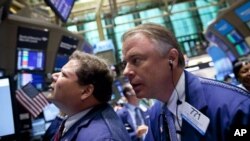The downgrading of U.S. creditworthiness by the Standard & Poor's rating agency late last week triggered the worst losses on U.S. financial markets Monday since the 2008 global economic crisis. But, investors still consider U.S. government securities to be among the world’s safest investments.
The Dow Jones Industrial Average fell below 11,000, dropping more than 630 points - about 5.5 percent on Monday. The Standard and Poor's 500 slid 6.7 percent, with every stock listed on the index ending the day in negative territory. The technology-heavy NASDAQ index was down 6.9 percent.
Doug Roberts, chief investment strategist for Channel Capital Research, attributes the sell-off to the loss of America’s highly regarded AAA bond rating.
“Right now, we saw basically the aftermath of the S&P downgrade and that put in a great deal of fear in the market and you saw the sell-off that results," said Roberts.
|
S&P lists 5 pillars in its Sovereign Rating Framework as: |
|
The price of gold reached a record high on Monday - more than $1,700 per ounce - as investors dumped stocks and sought safe haven in the precious metal. They also shifted money into U.S. government securities.
Peter Cardillo, chief market analyst with Rockwell Global Capital, notes the irony:
“People are not really afraid that the United States is not creditworthy," said Cardillo. "And as a result of that, they poured in - both foreigners and domestic investors - poured into the Treasury market.”
Cardillo says the fundamentals of the U.S. economy are strong and that the steep decline in U.S. stock prices during the past two weeks is a market correction, not a crash. He says the U.S. debt downgrade is a warning to American politicians.
“It sent a loud message to the politicians that gridlock should not continue and that they need to get their political aspirations put on the side, and they need to work a deficit reduction plan that will satisfy the ratings agencies, and, of course, will satisfy the markets in general," he said.
Analyst Doug Roberts says it is critical that Tuesday’s Federal Reserve meeting address short-term stock market volatility. He says fixing the problem over the long-run will involve painful reforms.
“There’s a huge amount of credit that was built up in the private sector that’s now being supported by an increase in the debt in the public sector, and until we look at some fundamental reforms to deal with this, which will be painful, this is likely to continue," he said.
Analyst Peter Cardillo says the fact that the market did not bounce up at the end of the day might indicate more declines on Tuesday.
Related video by Mil Arcega:

















